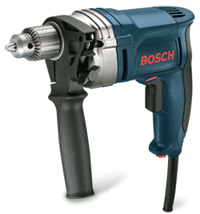You don't the permission to view this video
 Available in different chuck capacities, such as 1/4", 3/8" or 1/2". For example, 1/4" means that is the largest diameter shank that will fit the chuck. The speed of the drill also increases with the size.
Available in different chuck capacities, such as 1/4", 3/8" or 1/2". For example, 1/4" means that is the largest diameter shank that will fit the chuck. The speed of the drill also increases with the size.- Motor load limit can be light-, medium- or heady-duty. The higher the amp rating, the more powerful the drill. Drills rated at 2 amps are generally considered light-duty drills, while 5-amp drills are considered heavy-duty.
- Tighten the drill bit in place with a chuck. A keyed chuck uses a rotary key to tighten and loosen the chuck. A keyless chuck is operated by hand.
- Another feature on some drills is variable speed. They allow the operator to control the drill’s revolutions per minute, usually by varying pressure on the trigger switch. Some models also allow the user to vary the torque. Higher torque is better for driving screws, and higher speed is better for drilling holes.
- A good quality 1/4” drill can drill through concrete, metal, plastic and other materials. Better for high speed and not high torque. Better for sanding and buffing than 3/8” or 1/2” drill sizes.
- A 3/8” drill has more speed, but less power than a 1/2” drill. They are usually built with a double-reduction gear system. Can perform most of the drilling jobs a 1/4” drill can, and can handle a larger range of drill bits.
- A 1/2” drill has high torque and slow speed, which is ideal for making large holes in metal and wood. Best drill for use wtih hole saws.



Comments (0)